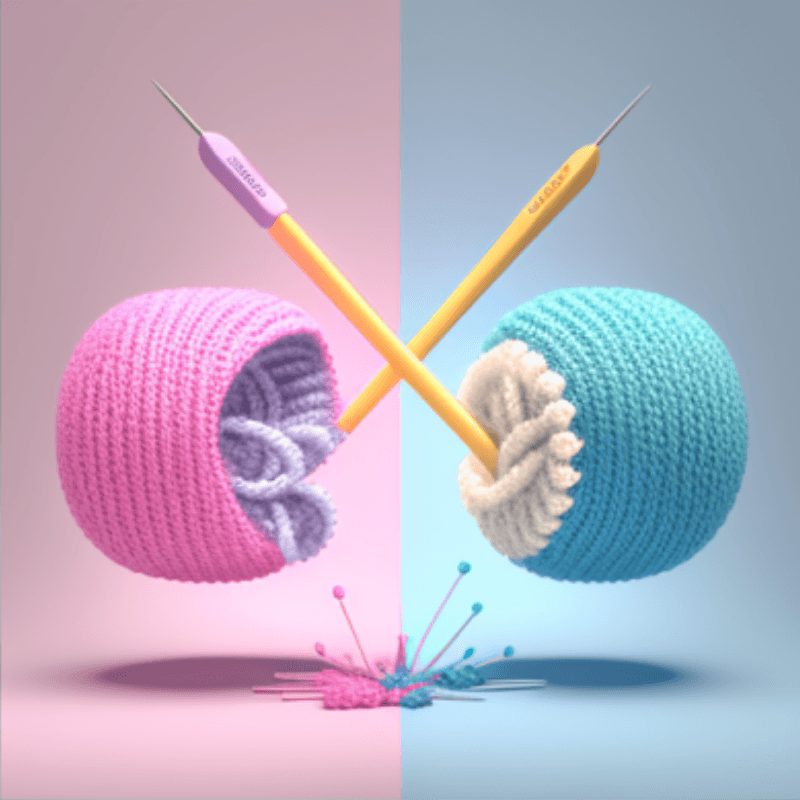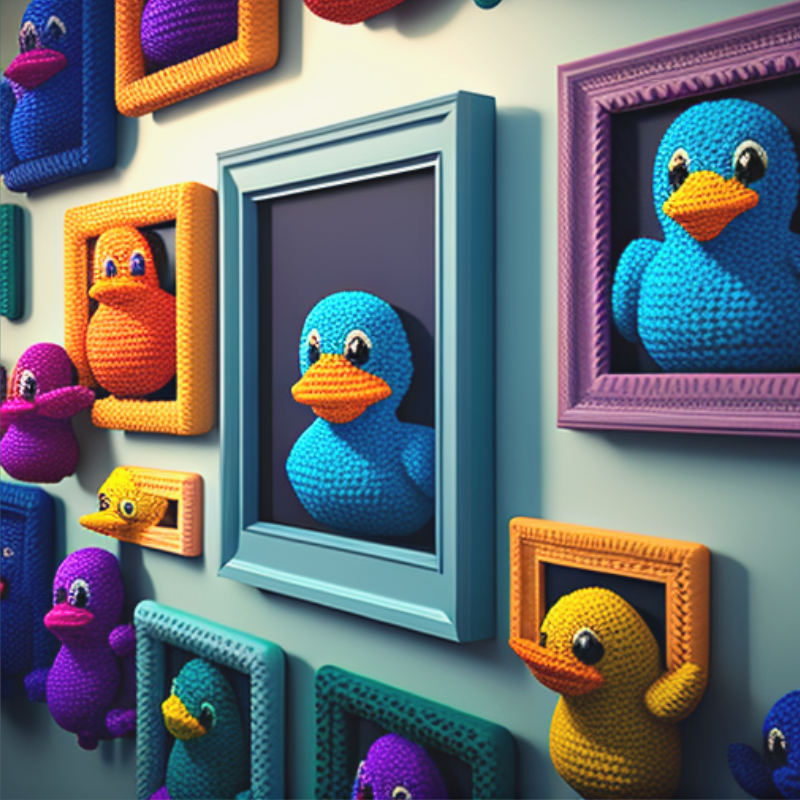Are you a beginner crafter looking to try your hand at fiber art? Or are you an experienced maker looking to branch out into a new craft? Either way, should I learn crocheting or knitting?
This comprehensive guide will explore the differences between crocheting and knitting to help you decide which craft is right. We'll cover everything from the basic tools and techniques to the unique characteristics of each craft, as well as some tips and tricks for success.
So grab your hooks and needles, and let's dive in!
The Basics of Crocheting
Crocheting is a fiber art that uses a single hook to create fabric by interlocking loops of yarn or thread. It's a versatile craft that can create many projects, from cozy blankets and scarves to intricate doilies and amigurumi toys.
Some of the basic tools you'll need for crocheting include:
- A crochet hook: Crochet hooks come in various sizes and materials, including aluminum, plastic, and bamboo. The hook size you choose will depend on the thickness of your yarn and the pattern you're following.
- Yarn: Crocheters use a variety of yarns, including wool, acrylic, cotton, and more. The type of yarn you choose will depend on your project and personal preference.
- Scissors: You'll need a pair of sharp scissors to cut your yarn when you're finished with a project or need to switch to a new color.
- A tapestry needle: A tapestry needle, also known as a yarn needle, is used to weave in loose ends and add embellishments to your crocheted projects.

Some of the basic techniques you'll need to know for crocheting include:
- Chain stitch: This is the foundation of most crocheted projects. To create a chain stitch, you'll need to loop the yarn over the hook and pull it through the loop on the hook to create a new loop.
- Single crochet: The single crochet stitch is a basic crochet stitch that creates a dense, solid fabric. To create a single crochet stitch, you'll need to insert your hook into the next stitch, yarn over, and pull the yarn through the stitch and the loop on your hook.
- Double crochet: The double crochet stitch is a taller stitch that creates a looser, more open fabric. To create a double crochet stitch, you'll need to yarn over, insert your hook into the next stitch, yarn over again, and pull the yarn through the stitch, completing the stitch with a final yarn over and pulling through all the loops on your hook.
The Basics of Knitting
Knitting is another fiber art that involves creating fabric by interlocking loops of yarn or thread. However, knitters use two pointed needles instead of a single hook to create their fabric.
Some of the basic tools you'll need for knitting include:
- Knitting needles: Knitting needles come in various sizes and materials, including wood, plastic, and metal. The size of the needles you choose will depend on the thickness of your yarn and the pattern you're following.
- Yarn: As with crocheting, knitters use a variety of yarns, including wool, acrylic, cotton, and more.
- Scissors: You'll need a pair of sharp scissors to cut your yarn when you're finished with a project or need to switch to a new color.
- A tapestry needle: Just like in crocheting, a tapestry needle is used to weave in loose ends and add embellishments to your knitted projects.

Some of the basic techniques you'll need to know for knitting include:
- Cast on: This is the foundation of most knitted projects. To cast on, you'll need to create a series of loops on your knitting needles to serve as the starting point for your fabric.
- Knit stitch: The knit stitch is the most basic and creates a smooth, even fabric. To create a knit stitch, you'll need to insert your right needle into the next loop on the left needle, wrap the yarn around the right needle, and pull the yarn through the loop, creating a new loop on the right needle.
- Purl stitch: The purl stitch is the reverse of the knit stitch and creates a bumpy, textured fabric. To create a purl stitch, you'll need to insert your right needle into the next loop on the left needle from the front to the back, wrap the yarn around the right needle, and pull the yarn through the loop, creating a new loop on the right needle.
Crocheting vs. Knitting: Which is Right for You?
Now that we've covered the basics of crocheting and knitting, you might be wondering which craft is right for you. Here are a few factors to consider:
- Speed: Crocheting might be the way to go if you're looking for a faster craft. Because crochet stitches are typically taller than knit stitches, you can cover more ground in less time. However, this doesn't mean that knitting is necessarily slower – it just means that it might take a bit longer to complete a project.
- Fineness: Knitting might be the way to go if you want to create a finer, more delicate fabric. Because knit stitches are smaller and more tightly packed, they create a smoother, more uniform fabric. Crochet stitches, on the other hand, tend to be more open and loose, creating a thicker, coarser fabric.
- Customization: Both crocheting and knitting offer plenty of opportunities for customization, but they go about it differently. You can customize your projects using different yarns, hooks, and stitch patterns in crocheting. In knitting, you can customize your projects using different yarns, needles, and stitch patterns and by shaping your fabric through increases and decreases.
- Portability: Knitting might be the way to go if you're looking for a craft you can take with you. Because knitting only requires a pair of needles and a ball of yarn, it's easy to tuck into a bag and take it wherever you go. Crocheting, however, requires a hook in addition to your yarn, which can be a bit bulkier and harder to carry around.
Crocheting vs. Knitting: Additional Factors to Consider
Stitch Patterns
One area where crocheting and knitting differ is the variety of available stitch patterns. In crocheting, countless different stitch patterns can be created using a combination of basic and specialty stitches. These stitch patterns can be as simple as basic single crochet or as complex as intricate lace patterns. Knitting also has a wide variety of stitch patterns, including ribbing, cables, and lace. However, because knitting requires two needles, it can be more challenging to execute some more complex stitch patterns.
Textures
Another factor to consider when choosing between crocheting and knitting is the variety of textures that can be achieved. Crocheting can create a wide range of textures, from smooth and even to textured and bumpy. This is because crocheters can manipulate the direction of their stitches, allowing them to create various textural effects. On the other hand, knitting tends to create a more uniform, even fabric. While it is possible to create textured fabrics in knitting, it requires more advanced techniques like cables and lace.
Versatility
Both crocheting and knitting are extremely versatile crafts that can create a wide range of projects. However, because crocheting uses a single hook to create fabric, it can be easier to create more intricate, 3-dimensional projects like amigurumi toys and intricate lace patterns. On the other hand, knitting is better suited to creating flat, even fabrics like scarves and blankets. Nevertheless, both crafts can create a wide range of projects, so it's really up to your preference and what you want to achieve.
Community
Another aspect to consider when choosing between crocheting and knitting is the community of crafters surrounding each craft. Both crocheting and knitting have large and active communities of makers who share patterns, tips, and support with one another. However, one craft may have a more active community, depending on where you live. Suppose you're looking to connect with other crafters. In that case, it might be worth considering the availability of local knitting or crocheting groups in your area.
Ease of Learning
Crocheting and knitting can both be learned by beginners, but some people find one craft easier to learn than the other. For example, crocheting is easier to pick up if you're a visual learner, as the single crochet stitch is easy to see and follow. However, you're more of a hands-on learner. On the other hand, knitting is easier to learn, as it involves using two needles to manipulate the yarn. In terms of resources, both crocheting and knitting have a wide variety of tutorials, classes, and instruction books available, so it's really a matter of personal preference and learning style.
Cost
The cost of crocheting or knitting can vary depending on your necessary tools and supplies. Both crafts require basic tools like hooks, needles, and yarn, which can range in price depending on your chosen materials and quality. That being said, both crocheting and knitting can be relatively inexpensive hobbies, especially if you.
Stress Relief
Both crocheting and knitting can be incredibly relaxing and meditative activities, making them excellent choices for stress relief. The repetitive nature of the crafts can calm the mind and promote a sense of mindfulness. In addition, the sense of accomplishment that comes with creating something beautiful with your hands can be incredibly satisfying. Whether you're working on a simple scarf or a complex lace shawl, the therapeutic benefits of crocheting and knitting are hard to beat.
Physical Benefits
In addition to their stress-relieving benefits, crocheting and knitting can also have positive physical effects. Using fine motor skills in both crafts can help improve hand-eye coordination and dexterity, and manipulating the yarn can provide a gentle hand and wrist workout. In addition, the concentration required to complete a project can improve focus and concentration, making crocheting and knitting excellent brain games.
Therapy
The relaxing nature of crocheting and knitting has led to using both crafts as therapeutic activities in various settings. In occupational therapy, for example, crocheting and knitting can improve fine motor skills and hand-eye coordination, as well as provide a sense of accomplishment and purpose. In mental health settings, crocheting and knitting can be used as a form of expressive therapy, allowing individuals to work through emotions and cope with stress through the creative process.
Fashion
Crocheting and knitting have long been used to create custom garments and accessories. However, in recent years there has been a resurgence of interest in handmade clothing and accessories. Whether you're looking to create a one-of-a-kind sweater or a statement piece of jewelry, crocheting, and knitting offer endless possibilities for fashion-forward creations. In addition, the popularity of slow and sustainable fashion has led to an increase in demand for handmade items, making crocheting and knitting excellent choices for crafters looking to tap into this trend.
Conclusion:
So, which is the better craft: crocheting or knitting? The answer, of course, depends on your personal preferences and goals. Both crocheting and knitting offer unique challenges and rewards, and the best craft for you will depend on your goal.
Whether you choose crocheting or knitting, the most important thing is to have fun and enjoy creating something with your hands.

